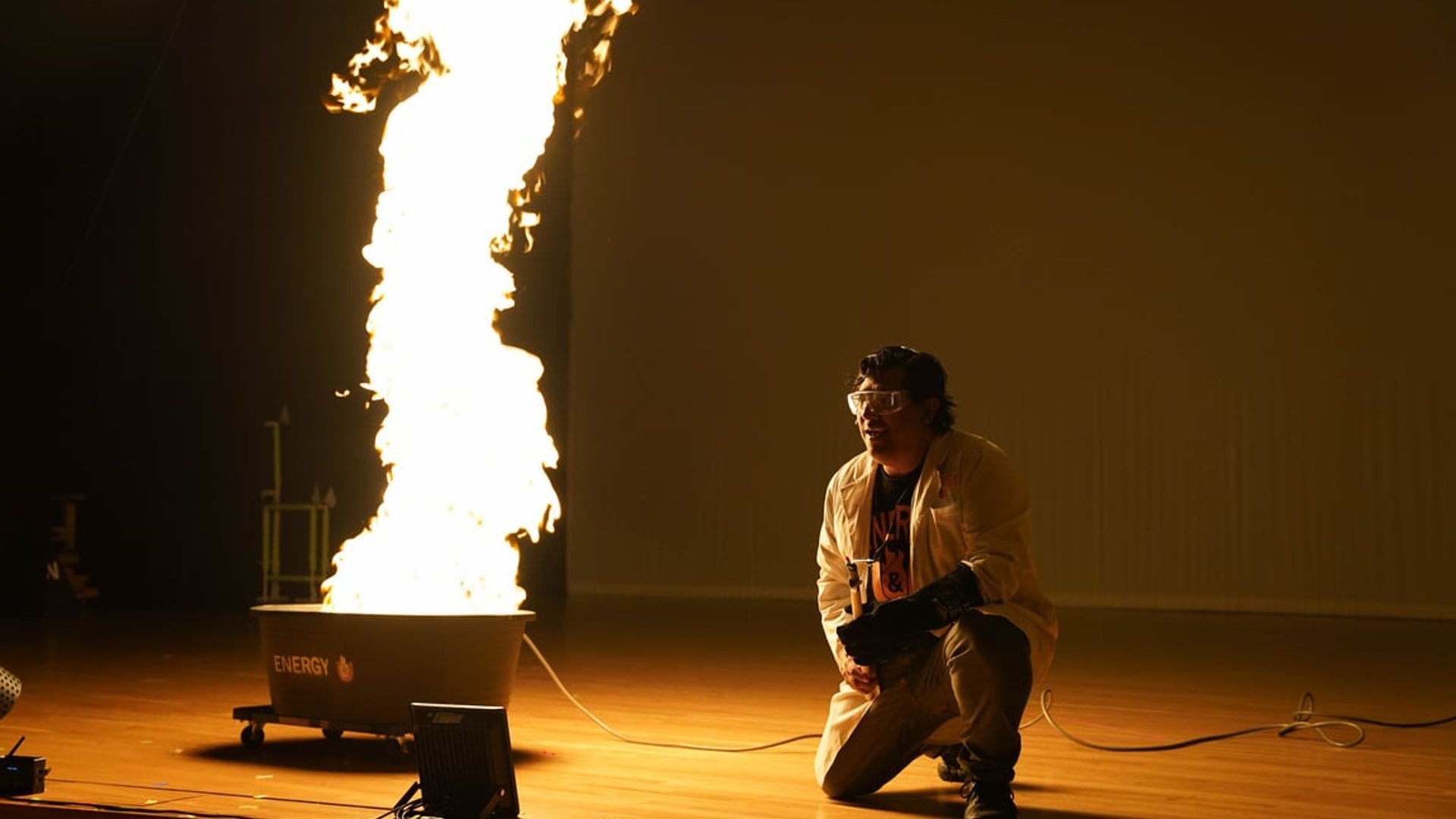By Divya Abhat, PREM Web Team
Each year, nearly 8,000 school-age kids watch PREM researchers at the University of Texas at Rio Grande Valley (UTRGV) deliver awe-inspiring performances: a race between two people to lift a one-ton weight, gummy bears that burst loudly into flames, giant pendulums or wrecking balls swinging dangerously close to the face, and dance—so much dance.
Each demonstration and dance performance centers around a unifying theme: the first law of thermodynamics—energy can neither be created nor destroyed, only transformed.
Consider the pendulum: when pulled just an inch from the face and released with zero initial speed, it won’t come any closer on its return swing. That’s because the total energy in the system remains constant. What begins as gravitational potential energy (pulling it back) becomes kinetic energy (as it swings), then converts back to gravitational potential energy (at its highest point)—with no extra energy created along the way.
This is Energy and U, and at the beginning and end of each show, the young audiences comprised mostly of elementary school kids are asked to complete a survey that asks whether energy can be created and destroyed. “What we find is that the students learn in the process of having fun,” says Arturo Fuentes, PREM Co-PI at UTRGV.
The ultimate research question behind these engaging performances is whether early understanding of a fundamental STEM concept translates into a future career in the field. Researchers will continue to track these young kids to gather data toward that question.
A Close Collaboration
Energy and U originated in 2007 at the University of Minnesota (UMN) as a collaboration between the Chemistry and Chemical Engineering and Materials Science departments with a goal of getting kids excited about science and engineering. In 2015, UMN MRSEC and UTRGV jointly received a PREM award, and a couple of years later, the former invited the latter to see the show.
The UTRGV team had the opportunity to watch rehearsals, meet technicians and talent, and get a feel for what went into each performance. In 2019, they received an Advancing Informal STEM Learning grant from NSF to bring the show to UTRGV, with Karen Lozano, professor and director of the UTRGV Nanotechnology Center of Excellence serving as PI and Aaron Massari, professor at UMN, serving as Co-PI.
The team recruited students and faculty, planned out demonstrations, reserved event spaces, worked out all the logistics, and then COVID hit. Lozano—former PREM PI for UTRGV—along with Fuentes, and the rest of the team pivoted online. That virtual show, which debuted in February 2021 with more than 9,000 registrations, was a huge success.
Two years later, more than 3,000 elementary students and others attended the first live performance of UTRGV’s Energy and U performance. Since then, the university has put on at least two week-long shows each year—typically one in January and one in May—where teams of roughly two dozen students and faculty cater to multiple thousands of kids across Rio Grande Valley. The sound, lights, content, and production value have earned a reputation of being truly spectacular: “This isn’t the typical chemical demonstration you have in the classroom,” says Fuentes. “This is a production.”
The UTRGV Energy and U Dance Team entertain their young audience, in the process converting chemical energy to mechanical energy. Image courtesy of PREM UTRGV.
The Language Component
The Rio Grande Valley has a large Spanish-speaking population, so the show is offered in both English and Spanish—always with the same goal: assessing whether kids can understand and retain what they see on stage.
In November 2022, the Spanish version of the virtual program, Energía Y TÚ, received a Lone Star Emmy Award—an honor recognizing excellence in television broadcasting across Texas.
Lozano, who served as producer, executive producer, and actor on the show, along with Jorge Vidal, who served as director and screenplay adaptor, attended the award ceremony. At UMN, Massari, who served as executive producer, along with professors Frank Bates, David Blank and Marc Hillmyer, all of whom served as script writers, were also recognized for their contributions.
Today, the Spanish version has been shared with numerous Spanish immersion schools, not just in Texas but also in Minnesota, with hopes to continue to expand and, in the process, make the program truly accessible through digitization and translation efforts.
The team also provides both printed and online resources as a way to keep the conversation going, ranging from targeted demonstration ideas to interactive and engaging games. The idea, says Fuentes, is for these students and their teachers to take what they learned back to the school and continue to do experiments. “It’s lighting the fire but also making sure that somebody is going to continue to feed that fire after the show.”
